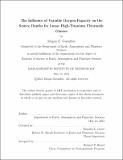The Influence of Variable Oxygen Fugacity on the Source Depths for Lunar High-Titanium Ultramafic Glasses
Author(s)
Guenther, Megan E.
DownloadThesis PDF (2.132Mb)
Advisor
Grove, Timothy L.
Terms of use
Metadata
Show full item recordAbstract
High pressure, high temperature experiments were carried out under variable oxygen fugacity conditions on lunar high titanium ultramafic glasses to determine the conditions of multiple saturation where both olivine and orthopyroxene are stable on the liquidus. The investigated compositions are the Apollo 17 Orange glass (A17O, 9.1 wt.% TiO₂), Apollo 15 Red glass (A15R, 13.8 wt.% TiO₂), and Apollo 14 Black glass (A14B, 16.4 wt.% TiO₂). Experimental temperatures and pressures varied from 1420-1590°C and 1.4 to 4.0 GPa. Graphite and iron metal capsules were used to control oxygen fugacity (𝑓ₒ₂) at 1.5 log units above the iron-wustite (IW) buffer and 2.1 log units below IW, respectively. Our results indicate that the olivine - orthopyroxene multiple saturation point (MSP) shifts to higher pressures in the Fe metal capsules for each glass, and the magnitude of the shift (ΔMSP) increases with increasing TiO₂ content, an effect previously noted in Krawczynski and Grove (2012). We propose that TiO₂ content does indeed play the most significant role in causing this shift due to the reduction of Ti⁴⁺ in an ilmenite melt component to Ti³⁺ in a titanium-enriched armalcolite melt component. Our results confirm the occurrence of a late-stage overturn of the lunar magma ocean, and we suggest that the source region of the high-titanium ultramafic magmas is more oxidizing than previously assumed. More oxidized source region conditions are necessary for these magmas to be buoyant relative to their surrounding lunar mantle.
Date issued
2021-06Department
Massachusetts Institute of Technology. Department of Earth, Atmospheric, and Planetary SciencesPublisher
Massachusetts Institute of Technology